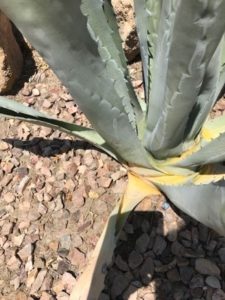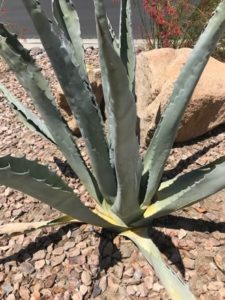When choosing a plant for the desert, one, but not the only way to gauge survival is to check the USDA Hardiness Zone for that particular plant. This information can (sometimes) be found on the plant tag, or by searching the internet for information pertaining to the plant you are considering. The Coachella Valley is in USDA zone 9b, which encompasses a low temperature range of 25 to 30 degrees. Here is a USDA zone map for the state of California: https://planthardiness.ars.usda.gov/PHZMWeb/.
This rating, however, only encompasses low temps, not high temps, so be sure to ask a nurseryman before buying or ordering a plant. Often if you can’t find it in a local nursery, it is because it won’t survive our extreme heat. Conversely, if you do see it at a big box store, it might survive the desert heat, but not for long! Many other factors affect survivability too – sun vs. shade, water needs, directional exposure and soil nutrients, just to name a few. Good questions to ask are “have I ever seen this actually growing in our area?” Or, “how much am I willing to risk to see if it will grow?”
Recently I purchased a tiny pot of cilantro at a hardware store. Now a hardware store is not where I usually buy my plants, but it was there, and there you have it. In the pot was a plant tag, and on the tag was a website called bloomiq.com. Never having heard of this website and being the inquisitive type, I did an online search when I got home. What did I find? An extremely comprehensive website featuring:
- A searchable plant catalogue with photos and growing details including hardiness zone ratings
- Plant collections by topic – hummingbirds, deer resistant, sun, shade
- A section called “Inspiration” which contains among other subjects, a directory of cut flowers with care tips, a piece on Fairy Gardens, one about Fertilizer and one I found especially interesting – "Vertical Gardens"
And there is so much more!
The website is owned by MultiPackaging Solutions. FYI – MultiPackaging Solutions is a leading manufacturer of inventory and custom-made tags, signs and other marketing materials for plant growers and garden centers; cards, wraps, baskets, bows and other supplies for the florist industry; and labels, boxes and other packaging materials for pharmaceuticals and other industries.
Now you will still need to evaluate your proposed garden addition prior to buying, but this website just might help you make the decision. I encourage you to do some “kitchen table surfing” on bloomiq.com when you have some free time!
Although a website can be a good source of info, nothing beats having someone with “local knowledge.” SCSH Desert Gardeners Club Member Jim Kieft is the club’s “go-to” guy for all things garden related. Jim is retired from a long career in the gardening and landscape industry. Most recently he worked at Moller’s Garden Center. Jim recently answered a question about an agave that was yellowing at the base. The homeowner thought it might be a disease, but the answer was actually “too much water”. Water was being applied twice a day by the home irrigation system. Given our marginally designed irrigation systems, the quantity of water that each plant receives can be difficult to control. Jim suggested that this agave be watered with a handheld hose not more than three times per week. Water should be applied away from the base of the plant to encourage roots to spread in the search for water. Watering a few times per week gives the soil a chance to dry out before new water is applied, discouraging root rot.
In lieu of hand-watering, homeowners with this issue might want to evaluate the watering capacity and location of the drip head being used on the plant. If the drip head is dispensing a large amount of water over the designated time, i.e. 1 gal. per hour over “x” time, a lower-flow head could be used. Also, if there is just one dripper at the base of the plant, drip heads could instead be placed in a circle around the plant, each dispensing a lesser quantity of water over “x” time. Using a reputable irrigation expert is always recommended for major system changes.
I just have to mention that being a member of the SCSH Desert Gardeners Club gives you access to this expertise as well as a wealth of other gardening information via our website, meetings and field trips. Check us out at scshdesertgardeners.com.
One last thing to consider . . . a largely un-mentioned benefit of having Frontier Communications as the universal provider of internet for SCSH is year-round vs. “seasonal” internet service. There are so many internet-based safety and convenience products available now – smoke alarms, security cameras, alarm systems and doorbells. Did you know there are wi-fi based irrigation controllers? I have one and have found it to be extremely helpful in managing the water needs of my landscaping, even while I am in Colorado! Our next post on “SCSH Stay Connected to Nature” will likely be about this type of irrigation timer, so be sure to check back!
Submitted by:
Amy Tomlinson, President, SCSH Desert Gardeners Club
Corey Unfried, SCSH Desert Gardeners Club, Membership Chair
Jim Kieft, Member-at-large and “Go-To” Guy


